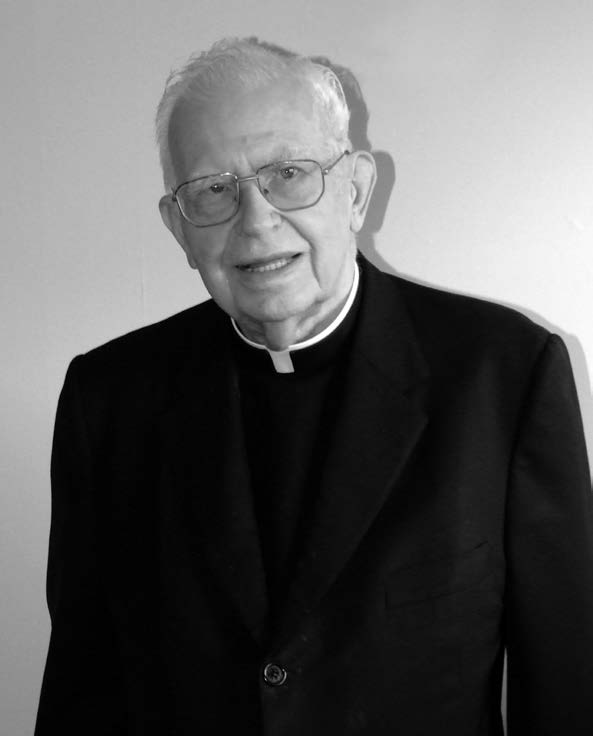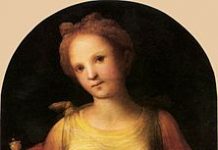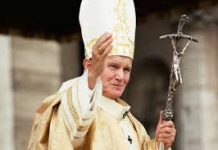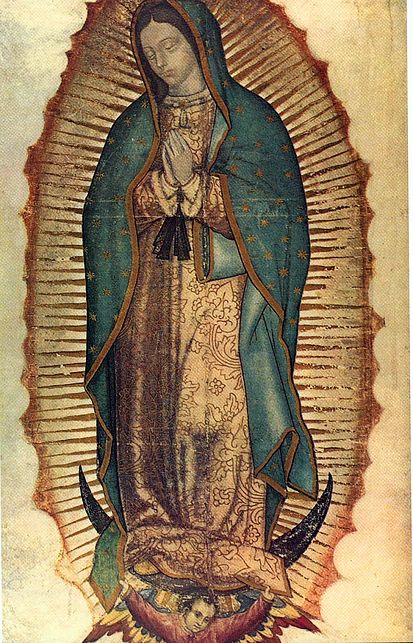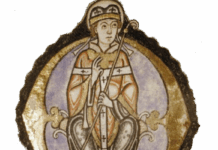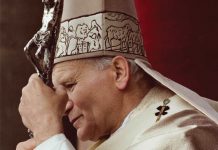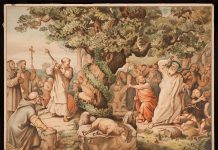Sermon by Rev. Msgr. Vincent Nicholas Foy (August 14, 1915 – March 13, 2017), preached at St. Francis of Assisi church in Toronto on Holy Thursday, April 6, 1950
Part 1: Monuments to Men
Men, my dear brethren, when they wish some event or some person to be remembered, erect a monument to that event or that person. Our world and strewn with monuments, the attempt of the past to have itself remembered in the future. Notable monuments are the great pyramids and Sphinx of Egypt and the temples of Greece and Rome. In Paris is the famous tomb of Napoleon and the Triumphal Arch. In London is the tall column and statue in Trafalgar Square in honour of Nelson. Our own Canadian parks are dotted with statues to our Canadian heroes and statesman and our graveyards are filled with stones and crosses in memory of our dead.
Perhaps the greatest monument builders of all were the Mughals of India and the greatest of these was the Shah Jahan. He was a contemporary of Henry IV and Queen Elizabeth of England. In his own honour, he built the great Mughal Palace at Delhi, one of the most magnificent buildings in the world. John L. Stoddard, the great travel lecturer, tells us that no words are adequate to describe its sculpt and loveliness. In it there are literally miles of garlands, wreaths, vines, and flowers sculptured of precious stones. Its long corridors and rooms are paved, roofed, and lavished with purest marble. The tomb ordered built by Shah Jahan for himself was the famous “Peacock Theme,” one of the marvels of the world.
Jeweler’s labored for seven years in its construction and its value was no less than thirty million dollars. Then to entomb the body of his beloved wife, Shah Jahan had built, what is generally conceded to be the most perfect statue in the world, the Taj Mahal. It is the one completely faultless edifice that ever has reared. It was begun in the year 1630 and occupied 20,000 men for twenty years. It is a delicately sculptured mountain of Alabaster, supporting in its crest a sparkling dome. Into it were poured all the richest jewels and stones from the Mughal Treasury.
The writing of the history of Shah Jehan is this: on the walls of his great palace he had inscribed in exquisite mosaic a Persian verse whose meaning is “If there be a paradise on Earth, it is here.” Yet Shah Jahan was never permitted to occupy his palace; nor when the Taj Mahal was completed could he enter it to weep beside his beloved wife’s grave. His own son, the son of her who was entombed in the Taj Mahal, overthrew Shaw Jehan, and confined him to prison where he spent the last seven years of his embittered life.
So passes the glory of this world. And now, after over 300 years, incipient signs of corrosion are creeping into the great monuments of Shah Jahan.
Part 2: A monument to God
My dear brethren, the Mughal Palace at Delhi and the Taj Mahal at Agra are typical of most human monuments. No matter what their beauty nor what noble ends inspired them, they are dead things, built by man, and corruptible. They bear little or no relation to present life and very often they were built to satisfy a vanity that was defeated.
There is a monument and a memorial which bears none of these imperfections and the institution of which we celebrate today. This evening besides celebrating the anniversary of the truly great events in human history, we celebrate the institution of the greatest monument of all time.
Today, as you know, my dear brethren, many Catholics follow the laudable custom of making a visit to seven different churches to visit our lord in the Blessed Eucharist. And if we were to examine the history of this custom, we would find that it goes back to early Christian times when the Christians of Rome on Holy Thursday visited the seven principal churches of Rome. And what was the inspiration of this devotion? It was that on the first Holy Thursday, the eve of the day of our redemption by blood, there was given to the human race, the supreme monument and gift of God, Christ in the Eucharist.
Once more, in this anniversary we are naturally inclined to fix our attention on the solemn event of The Last Supper, which was also the first Eucharistic banquet.
Christ and his twelve Apostles are reclining at the Pascal table. Our Lord knows as He sits there that within a day every drop of blood will be drained from His veins. He knows that the soul of Judas is already blackened with the sin of selling for silver the Son of God; and that already it has been agreed upon that He should be betrayed by a kiss. Around Christ in the hearts of Judas, the High Priests, the scribes, and the pharisees the emotion of hate is welling stronger.
The atmosphere around Christ is heavy with hate. Yet here is the seeming contradiction. While men were planning the greatest act of hate Christ gave us the greatest gift of His love. At the very moment when the Jewish leaders were trying to remove Jesus from among the people, Our Lord instituted the means by which He would stay with them until the end of time.
So surrounded by hate, in Christ Himself at the Last Supper, there is only love. He says, “A new commandment I give unto you, that you love one another as I have loved you.” And then He says, “With desire I have desired to eat this Pasch with you, before I suffer.” And taking bread into His hands He says, “This is my Body” and taking wine, He says: “This is the chalice of My Blood,” and “Do this for a commemoration of Me.”
So it was that Christ made his last will and testament before he died, bequeathing to us the Supreme Memorial of the Eucharist – to stay with us until the end of time.
Part 3: The Eucharist is the greatest of all the sacraments.
Let us see how the Eucharist surpasses all human monuments to an infinite degree.
- The Eucharist is a memorial raised by God Himself. All others are the work of men.
- Human monuments are but imitations of the virginal or buildings of stone, wood, plaster, or metal, but the Eucharist is Christ Himself, in His Body, Blood, Soul and Divinity. The same Christ who walked and talked in Palestine nearly 2000 years ago. On our altar this evening is the same Christ who as a baby shivered in the manger at Bethlehem, who as a boy played in the streets of Nazareth and as a man raised Lazarus to life, healed Bartimeus the blind man, stilled the waves of the Sea of Galilee and healed the daughter of the Canaanite Woman.
- Human monuments are dead. But in the Eucharist, we have Christ our beloved living on our altar.
- Human monuments are corruptible. The nice smooth surface of the pyramids is worn away, exposing the great rough blocks of stone underneath and there are cracks in the Taj Mahal. The Eucharist is incorruptible. It will be renewed from the rising of the sun until the going down thereof, as prophesied in the Old Testament, until the end of time.
- Human monuments are built for the glory only of those for whom they are raised. The Eucharist was given us not only as a monument to Christ, but He instituted it also for us. It was instituted not to satisfy vanity, but charity. It is not something that bears no relation to our present lives, but something that can have a very powerful influence on our present lives and on our eternal happiness.
Part 4
My dear brethren, when Christ said, “Do this for a commemoration of Me,” what did He wish to recall to us; what did He wish to be commemorated by the monument of the Eucharist? To what is the Eucharist a memorial?
- First of all, the Eucharist is a memorial to the love of Christ for us and the love of God for us. When one person loves another, there is a desire to be near that other person. God so loved us that He gave us His only begotten Son, and this only begotten Son so loved us that He gave Himself to us, not only on the Cross, but in the Eucharist to remain with us in a spiritual way unto the consummation of the world. We do not need further proof of God’s love than His Presence in the Eucharist. His infinite condescension is beyond our understanding. All we know is that it is a reality, that God himself dwells with us in the Host as He dwelt with the Israelites in the desert in a cloud by day and the pillar of fire by night. He dwells with us to help us. He is, in the words of Fr. Le Buffe, “Our Changeless Friend.”
- Secondly, the Eucharist is a memorial to the passion of Christ. Christ present in the Host is a living monument to the history of our redemption by the Cross. As the prayer says which the priest recites in giving Communion outside of Mass: it recalls the memory of His Passion. It recalls Our Lord sorrowful unto death in the Garden of Gethsemane while His disciples slept. It recalls Christ our King standing before Pilate after a night of agony, with a reed His scepter, thorns piercing His flesh His crown and the soldiers coat His regal gown. It recalls the heavy lash weighted with lead which tore into His sacred body. It recalls the heavy Cross cutting into His shoulder on the way to Calvary. It recalls the sound of the hammers beating thick blunt nails into His hands and feet. It recalls the gall-soaked sponge being pushed into His mouth. It recalls the spear being thrust into His side and the last drop of His blood, the first payment for our sins, dropping to the ground of Calvary.
And when Jesus was hanging dead and bloodless on a criminal’s cross, they that passed by blasphemed and wagged their heads saying, “Vah, thou that destroyest the temple of God and in three days dost rebuild it: save thy own self. If thou be the Son of God come down from the Cross.”
“In like manner also the chief priests, with the scribes and ancients mocked Him saying if He be the king of Israel, let Him come down from the Cross: and we will believe Him.”
My dear brethren, Christ did come down from the Cross. He came down from the Cross to our tabernacles. Though we rejected Him through sin, He returns this rejection by love for us. No monument, no pyramid, no obelisk, no statue or carving or painting or sculpture erected by the might and intelligence of man can or could compare with the memorial we have on our altar.
Part 5
My brethren, what lessons, we may ask, are to be learned and what benefits are to be derived from the consideration of the Eucharist as a living memorial?
- Considering that Christ is present in the Eucharist as a memorial to His love for us, we have in the Eucharist Christ a sure friend to whom we should go too often in prayer. His special presence is a great help to our prayers. We know how much it helps our devotion in praying to the Blessed Virgin, or Saint Theresa, or Saint Anthony if we pray before a statue in their honour. It helps to realize their presence. In a still greater way, our devotion to Christ is aided when we realize that He is truly present in the Eucharist out of love for us. Waiting behind the Tabernacle veil for us to come to Him with our problems, our worries, and heartaches, waiting there to receive our homage and thanksgiving. Reflection on this should help us to realize the value of frequent visits to the Blessed Sacrament and frequent attendance at Benediction, Holy Hours, the Forty Hours’ devotion, and other devotions in his honour.
- Considering that Christ is present in the Eucharist and especially at Mass, as a reminder of His Passion for us, we should, as the Mass unfolds before us the sacrifice of the Cross in an unbloody manner, recall the sacrifice of blood on Calvary. If we follow the Mass with a Missal, we will be continually reminded of this. In our visits to the Blessed Sacrament, let the cross over the Tabernacle recall that the Eucharist is a monument to the Passion and death of Christ. Let the Eucharist give us the strong determination to see that in our individual case the Blood of Christ did not drip from the Cross of Calgary to the ground of Calvary in vain. Let it give us the resolution to spread the true conception, meaning and importance of the Redemption by blood to others: by prayer, mortification, and good example. In this way, my dear brethren, the purpose for which the great memorial of the Eucharist was instituted is fulfilled. In this way, the last Will and Testament of Christ made on the first Holy Thursday and later signed With His Blood is executed and we fulfil the words “Do this for a Commemoration of Me.”
This handwritten sermon by + Msgr. Vincent Nicholas Foy, was typed for the first time on Ash Wednesday, March 5, 2025 by Staff of EUCHARISTIC ADORATION – www.perpetualeucharisticadoration.com
Msgr. Foy’s handwritten notes can be viewed on his website.
A printable copy of this sermon may be found here.
After a long day working at the chancery offices, Msgr. Foy would travel far to be the guest preacher at Forty Hour devotions with exposition at parishes. He was a co-founder and director of a charity, which assists parishes with expanding Eucharistic and perpetual adoration.
Msgr. Foy is known as the longest ordained and oldest diocesan priest in the history of the Archdiocese of Toronto and the longest ordained Anglophone diocesan priest in the history of Canada. Worldwide, four served longer.

